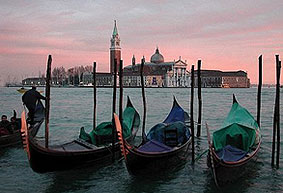


All the structures

Venice, city of dreams… is mentioned in the best literature, in the theatre and in many films.
Venice has always been a focal point of Europe’s political and economic history, particularly in the Mediterranean area. It contains many famous artistic masterpieces. Venice is surrounded by a wide range of landscapes.
Encircled by its lagoon, Venice is queen of the most humid area in Italy.
Tradition has it that Venice was founded on 25th March 421, when in order to escape the Lombards, the inhabitants of the X Roman Region occupied the islands in the lagoon. By 770 the inhabitants of the lagoon had a bishop, and some forty years later the political centre moved to the area of today’s Rialto. Venice began to dominate the seas and to be a crucial military and trading centre, conquering the whole Mediterranean.
The largest of the city’s canals is the ‘S’-shaped Grand Canal. The Grand Canal is about four kilometres long and divides the city into two parts. The Venetians refer to the noblest part of Venice, the St. Mark’s side, as ‘this side of the Canal’, and Venice’s more populated area as ‘the other side of the Canal’. The Grand Canal winds between magical noble palaces, it has about 45 offshoots (ria) and three bridges: Rialto, Accademia and Scalzi. A visit to Venice means immersing oneself a very special atmosphere created by the combination of water and architecture.
Piazza San Marco with the Clock Tower, the Basilica of San Marco, San Zaccaria and Cà D'Oro are just some of the precious works of art that make Venice one of the most important cities in the world.
Visit the small island of San Giorgio Maggiore in the lagoon. The Giudecca is a set of islands connected by reclaimed land and bridges. Murano, renowned for its independence, is very important today for its glass factories, which in fact are kept away from Venice to avoid the danger of fires. The island of Burano has retained its original appearance the most. At the beginning of the sixteenth century Burano began to develop the craft of lacemaking. Torcello is another of Venice’s focal points and was where the importance of the city began.
Chioggia is located close to Venice; visit S. Martin’s, its thousand-year-old Gothic Cathedral, and the Old Granary from 1322.
In the years between the fifteenth and the eighteenth century Venetian families built prestigious country houses now known as ‘Venetian villas’, which differ from one another depending on when they were built and their architectural style. Common points are that they all comprise a manor house and farm, and have spacious gardens and parks.